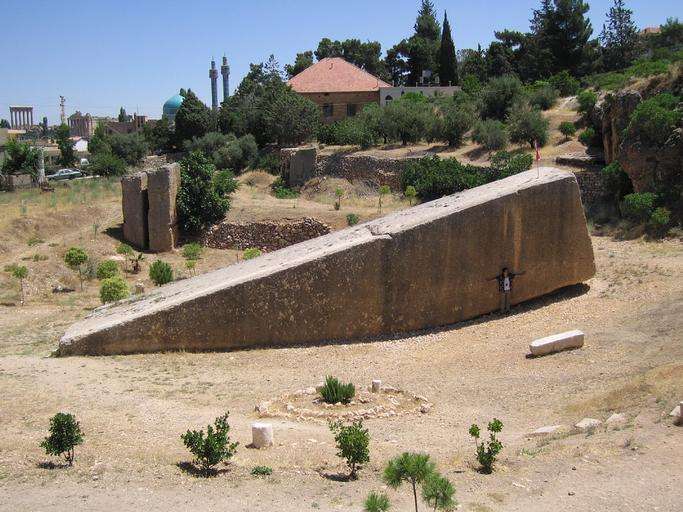Baalbek, Lebanon

In Baalbek, Lebanon lie six enormous stone blocks whose megalithic sizes have been unparalleled since their creation. The smallest three, known as the Trilithon, lay as the foundation for the Temple of Jupiter which was so colossal that it took three centuries to complete. Each of these stones is 19 meters long, 4.2 meters high, and 3.6 meters wide, and is estimated to weigh about 830–880 tons.
The remaining three are not part of any structure but are believed to have been intended for use in the same complex.
Stone of the Pregnant Woman
The smallest of the three, known as the Stone of the Pregnant Woman, is believed to have gotten its name from a pregnant woman who convinced the people of Baalbek that she knew how the stones were moved, but would only tell them if they agreed to feed her until she gave birth. Weighing 1,000.12 tons having the dimensions 20.31–20.76 meters long, 4.14–5.29 meters wide, and 4.21–4.32 meters high, the stone is the more famous of the three due in part to its condition, never having been fully buried, though the stone was discovered to have a crack that would have impeded its transport.
Stone of the South
The stone of the south discovered in the 1990s, measures 19.5–20.5 meters long, 4.34–4.56 meters wide, and 4.5 meters high, weighing an estimated 1,242 tons.
Forgotten Stone
In 2014 archeologists from the German Archaeological Institute found another megalithic stone right next to the Stone of the Pregnant Woman and aptly named it the Forgotten Stone. The Forgotten Stone with its weight estimated at a staggering 1,650 tons, and having dimensions of 19.6 meters long, 6 meters wide, and 5.5 meters high, would turn out to be the largest known stone ever quarried.
An Advanced Technology?
There is no dispute among researchers that the temple of Jupiter was built by the Romans beginning construction around 15 B.C. when the region became a Roman province. The debate however centers around the how and the why. Scientific calculations show that the stones holding up the temple’s podium are much larger than needed, and with the amount of time necessary to complete the project directly related to the work performed to quarry these massive stones, one has to ask, why the impractical size?
If you skip over the question of why, the elephant in the room becomes the how. How did the people of the era move such massive stones when today the same feat would require the coordinated efforts of our largest and most sophisticated machines? Was an advanced technology behind the methods that constructed the ancient temple?
Visit
Baalbeck Ruins, Baalbek, Baalbek District, Baalbek-Hermel Governorate, Lebanon
Comments